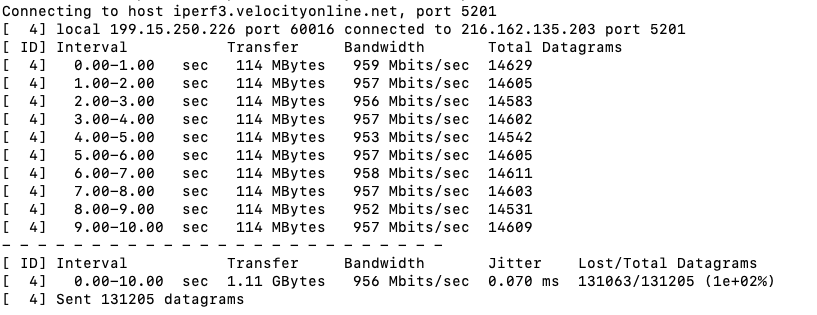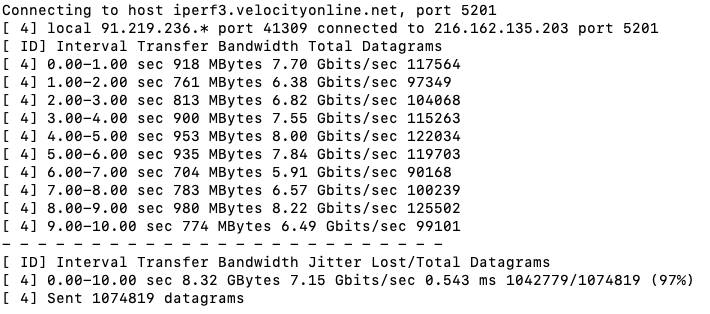How to Test Server Network Speed
Once you deploy a new cloud or dedicated server, you may be eager to test out the network speed to ensure you are getting what you paid for. Once upon a time, 100Mbps was the standard network connection speed for most dedicated servers. Times have certainly changed and ServerMania now offers dedicated servers with 10Gbps network connections and above.
In this article, we tackle how to test the network speed of your server and what speeds you can expect.
See Also: ServerMania 10Gbps Dedicated Servers
Will I see 10Gbps speeds when testing a 10Gbps connection?
The short answer to this question is no. Several factors impact the ability to see a 10Gbps download speed on a dedicated 10Gbps dedicated port including testing server limits, server hardware, network overhead, etc. We go into each of these in detail below.
That being said, even though you should not expect to see the entire port speed when testing to a single source, you can rest assured that you can fully leverage your 10Gbps port with ServerMania. These ports are completely dedicated to you and connected to dedicated 10Gbps transit. In real world situations where hundreds or thousands of connections are being made to your server, you can utilize the entire capacity of the server connection.
The Limitations of Testing Network Speed
Testing Server Limits
Before we get started, it’s important to note the limitations of testing a server’s network speed. When you are dealing with 10 or 20Gbps servers and above, you need to understand that the server you are testing the speed from also needs to be capable of reaching those speeds for a single user connecting to the test server. As you can imagine, most servers are not capable of reaching these speeds for a single connection.
The distance between your server and the testing server also needs to be considered, as this will introduce latency into the process which slows down the port speed.
10Gbps Dedicated Servers are much more popular for connecting to many users without having to sacrifice network performance or be slowed down by a congested server network connection. Most speed tests will not be able to show the entire speed limits of the connection.
See Also: (Live Webinar) Meet ServerMania: Transform Your Server Hosting Experience
Network Overhead
Another factor to consider when testing network speeds is network overhead. When transmitting information between networks, additional information is sent along with the data in order for the network to understand where to route the data. This extra information is called network overhead.
It means that when you transmiting data, you need to account for a percentage of speed loss required to send the control and signalling data (TCP) required to reach the destination.
With a 1Gbps connection, you can generally expect testing speeds between 900 and 950Mbps. 10Gbps servers may see speeds during testing of 6-7Gbit/s depending on the destination server.
See Also: How to Choose A Bandwidth Plan
Hardware Limitations
A final factor to consider when testing speed is the hardware limitations of your server. If you are using traditional SATA hard drives, then there will be a bottleneck of the hard drive IO speed while testing the connection. NVMe drives or RAID configurations help to reduce or eliminate this bottleneck. As well, you need sufficient CPU performance in order to leverage 10Gbps fully.
The Highway Analogy
When thinking about comparing network port speeds from 1Gbps to 10Gbps and above, a great analogy is to think of a 10 lane highway as compared to a single lane highway.
On a 10 lane highway, you can most certainly go faster than a single lane because there is less traffic in your way. 10 people could also drive at the same speed roughly as a single person on a one lane highway. However, it is not feasible to drive 10x as fast on a single connection. You need to factor in the limitations of your car (the destination server) and any network overhead needed.
Testing Server Network Speed
We have found that iperf is the best command for testing a single connection.
apt-get install iperf3
The following command will test the download of a 10GB file:
iperf3 -c iperf3.velocityonline.net -p 5201 -ub 10G
The results on a 1Gbps server may look similar to this:

As you can see, the results of 956Mbits per second accommodate for the network overhead of the 1Gbps server. At higher speeds, this overhead will represent a larger amount.
On a 10Gbps server, the test results will look something like this:

These test results accommodate the network overhead required, and any congestion that may be present on the testing server.
Deploying a 10Gbps Server
If you need a dedicated server with 10Gbps speeds or above, we recommend requesting a custom server quote. We can help review your server goals and assist you in choosing the right server for your requirements.
Was this page helpful?

